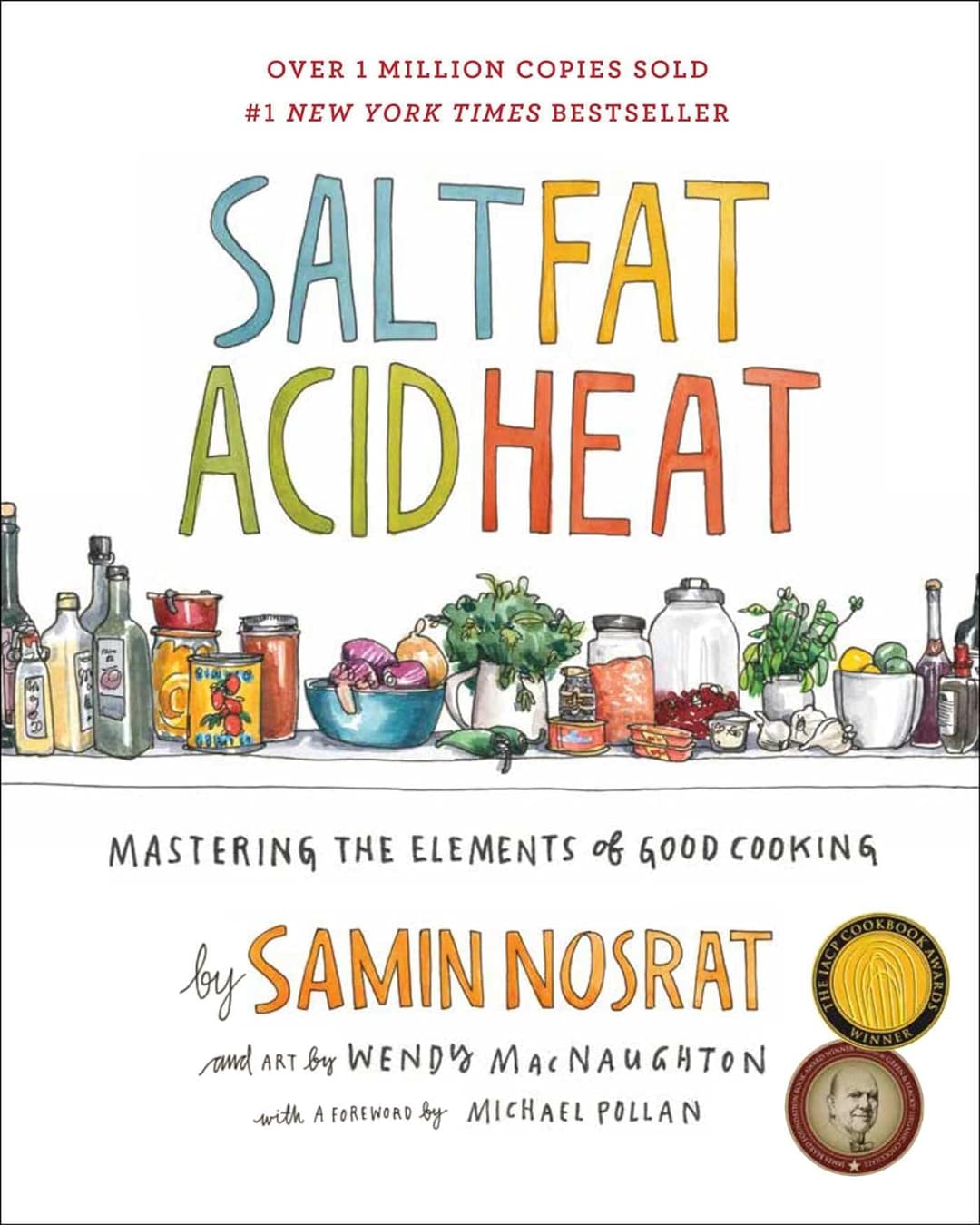
Salt, Fat, Acid, Heat
By: Samin Nosrat
Category: Health
Finished:
Highlights
Salt has a greater impact on flavor than any other ingredient. Learn to use it well, and your food will taste good. (Page 21)
Though we typically turn to sugar to balance out bitter flavors in a sauce or soup, it turns out that salt masks bitterness much more effectively than sugar. (Page 26)
Since diffusion is a slow process, seasoning in advance gives salt plenty of time to diffuse evenly throughout meat. This is how to season meat from within. A small amount of salt applied in advance will make a much bigger difference than a larger amount applied just before serving. (Page 30)
...season your cooking water until it's as salty as the sea... (Page 36) Pasta #Vegetables
...does the Olive Oil smell like a box of crayons, candle wax, or the oil floating on top of an old jar of peanut butter? If so, it's rancid. (Page 65)
My standbys include the extra-virgin oils from Seka Hills, Katz, and California Olive Ranch. Another good everyday oil is the Kirkland Signature Organic Extra Virgin Oil from Costco. (Page 66)
Just as l'd learned to constantly evaluate a dish for salt, now I knew I needed to always taste for acid, too. It was finally clear to me-acid is salt's alter ego. While salt enhances flavors, acid balances them. By acting as a foil to salt, fat, sugar, and starch, acid makes itself indispensable to everything we cook. (Page 103)
Acid also helps break down collagen, the main structural protein found in tough cuts of meat. Add wine or tomatoes as you begin to cook braises and stews, since the more quickly the collagen melts, the sooner the meat will grow juicy and succulent. (Page 114)
Always balance sweetness with acid, and not only in desserts. Roasted beets, full of sugar, benefit from a splash of red wine vinegar, which offers contrast to the naturally earthy flavor of beets that is so off-putting to some. Season them with olive oil and salt, and all of a sudden even the staunchest beet-phobe will be converted. Roasted Carrots, Cauliflower, and Broccoli-or anything that's developed sweetness from browning-will always appreciate a squeeze of Lemon or touch of Vinegar. (Page 126)
When aspiring chefs ask me for career advice, I offer a few tips: (Page 131)
Cook every single day.
Taste everything thoughtfully.
Go to the farmers' market and familiarize yourself with each season's produce.
Read everything Paula Wolfert, James Beard, Marcella Hazan, and Jane Grigson have written about food.
Food at room temperature cooks differently than food straight from the fridge. The same food will cook evenly or unevenly, quickly or slowly, depending on its temperature at the start of cooking. This is particularly true for meat, eggs, and dairy, whose temperamental proteins and fats are deeply affected by temperature swings. (Page 151)
Let all meats-except for the thinnest cuts-come to room temperature before you cook them. The larger the roast, the earlier you can pull it out of the fridge. (Page 151)
Make Risotto with arborio rice, a variety with a remarkable capacity to absorb an immense amount of liquid without falling apart. (Page 160)
Add too much food to too little water, and a pot's temperature will drop drastically. A rolling boil will come to a rocking halt. Pasta will clump. Basmati rice for Persian-ish Rice will stick. Pencil-thin asparagus spears will pile up on the bottom of the pot and cook unevenly. Do justice to any food you blanch and keep water at a rolling boil by using twice as much as you think you need.(Page 168)
For the most tender slices, cut meat against the grain, or the direction in which the muscle fibers run. Let your knife do the hard work of shortening the fibers by cutting right through them. The meat will be much more tender, and chewing it will be a lot more enjoyable. (Page 179)
Make 400°F your default temperature for Roasting Vegetables, but know that it will change based on the size of the vegetables, their density and molecular makeup, as well as the depth and material of your roasting pan and the amount of food on the tray or in the oven. (Page 184)
Food should almost always sizzle when it's added to a pan, signaling that the pan and the fat are both preheated. (Page 189)
Frozen fruits and vegetables are easy to forget about, but they tend to be harvested and flash-frozen at the peak of freshness. In the depths of winter-or at other times when nothing much else looks very good-frozen peas and corn can offer a welcome dose of spring and summer flavor. (Page 192)
Basic Braising Times (Page 351)
- Chicken Breast: 5 to 8 minutes if boneless, 15 to 18 minutes if on the bone. (If braising a whole chicken, split the breasts into quarters, cook them on the bone, and remove them from the pot when finished, about 15 to 18 minutes, allowing the legs to finish on their own.)
- Chicken Legs: 35 to 40 minutes
- Duck Legs: 12 to 2 hours
- Turkey Legs: 2½ to 3 hours
- Pork Shoulder: 2½ to 32 hours, longer if on the bone
- Bony Beef (Short Ribs, Osso Buco, Oxtail): 3 to 3½ hours
- Meaty Beef (Chuck Roast, Brisket, round): 3 to 32 hours
- Lamb Shoulder on the bone: 22 to 3 hours...
You can also always just cut into the Steak and take a peek. Or use an instant-read meat thermometer: (Page 355)
- 115°F for rare
- 125°F for medium-rare
- 135°F for medium
- 145°F for medium-well
- 155°F for well-done.
Pull meat from the heat at these temperatures, then let it rest 5 to 10 minutes. It'll carry over another five or so degrees, to the perfect level of doneness.

